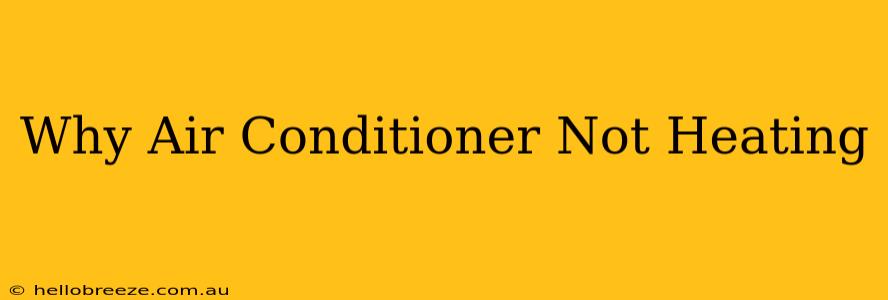Is your air conditioner refusing to heat your home when you need it most? A chilly blast instead of cozy warmth is incredibly frustrating. This comprehensive guide will walk you through the most common reasons why your AC unit might be failing to heat and provide practical troubleshooting steps. Understanding these issues can save you time, money, and potential discomfort.
Common Reasons Why Your Air Conditioner Won't Heat
Several factors can prevent your air conditioner from effectively providing heat. Let's explore some of the most frequent culprits:
1. Incorrect System Mode Selection:
This might seem obvious, but it's the most common reason! Ensure your thermostat is correctly set to "Heat" mode. Double-check that the system switch on the unit itself is also in the heating position. A simple oversight can lead to significant frustration.
2. Frozen Evaporator Coil:
A frozen evaporator coil is a frequent problem that prevents heating. This often occurs due to restricted airflow, a dirty air filter, or low refrigerant levels. Never attempt to defrost a frozen coil yourself without professional assistance. The refrigerant is under high pressure and handling it incorrectly can be dangerous.
3. Low Refrigerant:
Refrigerant is crucial for both heating and cooling. Low refrigerant levels can significantly impact the heating capacity of your system. This requires professional attention; attempting to add refrigerant yourself is dangerous and can damage the unit.
4. Faulty Heat Pump:
If your system is a heat pump, several components can malfunction and prevent heating. A faulty reversing valve is a common issue, preventing the system from switching between heating and cooling modes. Other potential problems include issues with the compressor, fan motor, or electrical components.
5. Dirty Air Filter:
A clogged air filter restricts airflow, preventing your system from operating efficiently and potentially leading to a frozen evaporator coil. Regularly replacing your air filter is crucial for optimal performance and preventing costly repairs. Aim to replace it every 1-3 months, depending on usage.
6. Electrical Problems:
Electrical issues, such as tripped breakers, faulty wiring, or problems with the capacitor, can prevent your system from functioning correctly. Checking your electrical panel and resetting tripped breakers is a good first step. However, more complex electrical problems require a qualified HVAC technician.
7. Defective Thermostat:
A malfunctioning thermostat can prevent your air conditioner from heating. Try replacing the batteries in your thermostat as a simple first step. If the problem persists, the thermostat itself might need replacing or professional attention.
Troubleshooting Steps: A Step-by-Step Guide
- Check the Thermostat: Confirm the system is set to "Heat" mode and the temperature is set higher than the current room temperature.
- Inspect the Air Filter: Replace a dirty filter. A clean filter is essential for proper airflow.
- Examine the Unit: Look for any visible signs of freezing, especially around the evaporator coil.
- Check the Breaker Box: Ensure the breaker controlling your HVAC system hasn't tripped. Reset it if necessary.
- Listen for Unusual Noises: Unusual noises, such as grinding or clicking, can indicate a mechanical problem requiring professional attention.
When to Call a Professional
If you've completed these basic troubleshooting steps and your air conditioner still won't heat, it's time to call a qualified HVAC technician. Attempting to fix complex problems yourself can worsen the issue and lead to costly repairs.
Remember: Safety is paramount. Never attempt to handle refrigerant or work on electrical components yourself unless you're a qualified professional.
By understanding the common causes and troubleshooting steps, you can effectively address many heating problems with your air conditioner. However, recognizing when professional help is needed is crucial for efficient repair and ensuring the longevity of your system.

